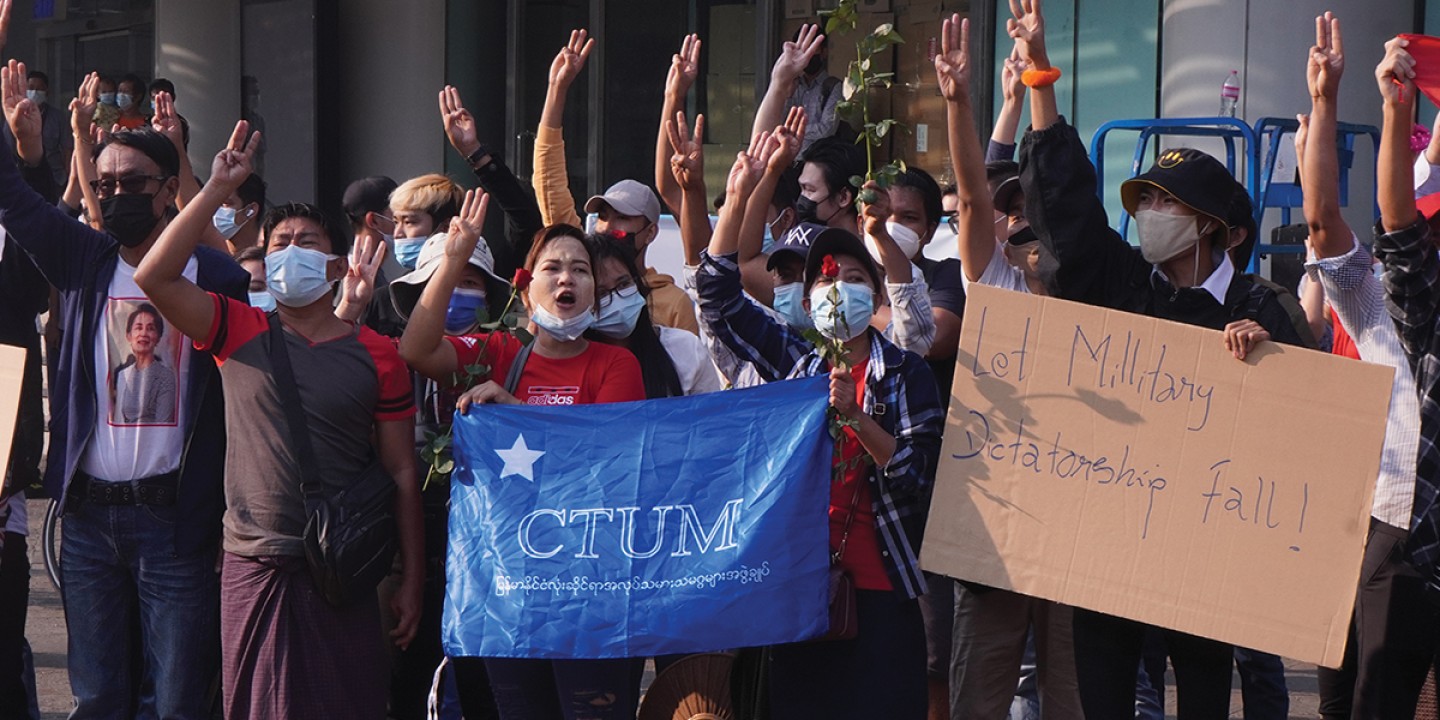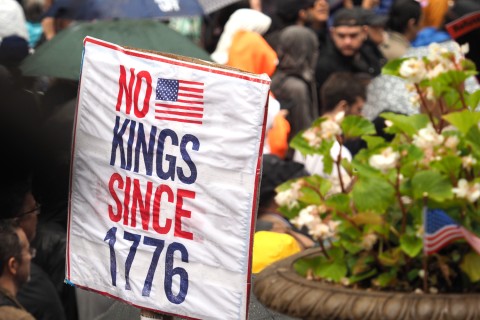Myanmar’s civil war has continued unabated for 60 years
How could a Buddhist country have one of the worst human rights records in the world?

These are difficult days in the country of Myanmar. Following years of house arrest and harassment, Aung San Suu Kyi was rehabilitated as state counselor in 2015. The party she leads, the National League for Democracy, took up seats in parliament for the first time. Despite her baffling refusal to condemn the genocide of the Rohingya Muslims, Burmese people continued to be loyal to her leadership and dared to believe the political tide had finally turned.
But another landslide election victory for the NLD in November 2020 was too much for the generals—who have led the country since a 1962 takeover—to stomach. Since February 2021, the full force of the military junta has cracked down on protesters once again. To date, more than 1,300 have died, and more than 8,000 have been detained or imprisoned. In December, Aung San Suu Kyi was arrested on trumped-up charges and now faces several prison sentences. Any influence she may have wielded seems to have evaporated.
Read our latest issue or browse back issues.
The national psyche of the Burmese people is defined by a long history of strong-armed leadership. Beginning in the 14th century, the rule of soldier-kings led to prosperity for some and to the subjugation of an assortment of distinct people groups within its borders. Then British colonialism led to two attritional wars and the capitulation by King Thibaw to the British at Mandalay in 1885.
The British ruled Burma as an annex to India. Governance was administered by divisional commissioners. While there were improvements to infrastructure, trade, and education, these were primarily self-serving reforms, and Burmese nationalists pressed for independence from the British, which came in 1948. Ensuing events cast the die for the unflinching style of government that was to follow. The new republican government was headed by General Aung San, Aung San Suu Kyi’s father. But in 1947, he and members of his cabinet were assassinated by a rogue terrorist, and attempts by Prime Minister U Nu to unite the country faltered and eventually failed.
The political vacuum was filled when the tanks of General Ne Win rumbled onto the streets of Rangoon in 1962. What distinguishes Burma from a host of other fledgling states that were developing in South Asia and Africa at the time is that a military dictatorship introduced nearly 60 years ago has proved to be incredibly resilient.
My personal introduction to Burma started on a school bus in London, where I met a beautiful Burmese girl. April and her family exiled themselves from Rangoon in 1964. Arriving at Heathrow with all but empty pockets, they left everything and everyone they knew behind. My fascination for this far-off land was fired by the warmth of April’s family.
But I knew little about Burma until April and I made an extended visit more than 30 years later. We ate with long-lost family members, met with Aung San Suu Kyi, and made new friends. But there was a sense of desolation in the country, a menacing military presence, and a grim resignation on the smog-filled streets of Yangon. I had difficulty reconciling what I had learned about the country’s grand past, natural beauty, and warm people with the depth of despondency that was now evident.
We continued to visit Myanmar between 2010 and 2018, and over time I came to more deeply understand the kind of Buddhism unique to Myanmar, the specificity of its ethnic divides, and how it had become a place that Amnesty International has determined has one of the worst human rights records in the world.
Yes, the negative stereotype portrayed by sporadic media reports seemed justified. But another, more nuanced story line began to emerge as well. The long-standing malaise in Myanmar can be explained, as many authoritarian regimes can, by the intransigence, secrecy, and repression of the militia. But Myanmar’s unique version of this all too common situation might also be explained, at least in part, by two things: the patchwork of different cultures across the country and the influence of two competing forms of Buddhism. Theravada is practiced by the majority, and a more militant form of Buddhism comes from a minority of monks at the heart of government.
The national borders of modern Myanmar stretch from Bangladesh and India in the west to an extensive and porous boundary with China to the north to Laos and Thailand on the eastern flank. Not only do many of the 130 ethnic groups have their own dialects and cultures, they also maintain their own militias.
For a decade or so following Burma’s independence in 1947, a federal political solution looked possible. Several presidents from different ethnic backgrounds led the new country. But since the military coup of 1962, the ruling Bamar people have refused to recognize the ethnic populations within their borders. For all their proud history and distinct subcultures, these various groups have been consistently excluded from political processes, forced to leave their lands and abandon their livelihoods. The result is the longest civil war in recent history, which has continued unabated for 60 years.
One example is the sweeping and systematic attempts by the Tatmadaw (the army) to force the Karenni from their homelands in Kayah State. First there was the Pya Ley Pya (Four Cuts) program, initiated in the mid-1960s. This was a sustained military strategy designed to cut the four key links between civilians and armed groups: food, funds, intelligence, and recruits. Then, between 1988 and 2000, amid widespread evidence of forced labor, arbitrary arrests, and extrajudicial executions, an estimated 30,000 civilians were forced to leave their homes. The current prognosis, two decades later, does not seem hopeful. Cease-fires and peace conferences come and go. Promises of political rights and reform all signal good intentions. But these overtures mean little to any of the minority peoples until internally displaced persons can return to their homes with safety and dignity.
A second factor that contributes to the malaise in Myanmar is the disconnect between the traditional pacifism of Theravada Buddhism and the nationalistic hate speech issued by monks close to the military. Buddhist beliefs like tolerance, compassion, pacifism, and profound respect for others have infused the Burmese mindset for centuries. Much early education depends on the monasteries, where spiritual wisdom and good morals are instilled. Golden temples and white stupas grace every town and village, and lines of monks, with their shaved heads and saffron-orange robes, collecting alms are a common sight. Armed revolt does not come easily to people with these beliefs.
When April and I met with Aung San Suu Kyi, soon after her release from house arrest, we saw how important her Buddhism was to her desire to end the country’s dictatorship. For her, nonviolence was the only way. Meanwhile, however, this nonviolent approach is contrasted by an influential group of nationalistic Buddhists in government who issue death threats, exercise brutality against their own citizens, and even promote genocide against small minority groups of Christians and Muslims.
This close connection between ethnic identity and religion is one of the vexing issues that undermine democracy in Myanmar. The military regime is renowned for its bullying nature, with frequent outbursts of extreme brutality. For long periods the peace-loving people have acquiesced. On the occasions when popular uprisings have occurred, they have been ferociously repressed. Students protested in 1988, and further protests erupted in 1990 when the regime refused to allow candidates for the newly formed NLD to take their legitimately won seats in government and placed Aung San Suu Kyi under house arrest. In 2007, the so-called Saffron Revolution sent monks out on the streets to protest government mismanagement and blatant inequalities. To witness soldiers shooting their compatriot monks at the front of the march was abhorrent to most Burmese onlookers.
Then in February 2021, the habitual tolerance of the Burmese people was once again stretched to a breaking point. Given the refusal of the junta to recognize another landslide victory for the NLD, populist demonstrations erupted in cities across Myanmar. Ominously, the 77th light infantry, which was at the forefront of brutally repelling the Rohingya uprising in 2017, was deployed to deal with the protesters on the streets of Yangon, Naypyidaw, and Mandalay—first with tear gas and rubber bullets and then with live rounds and even air attacks.
Are there any signs of hope for this embattled nation? Current events do not instill confidence. The generals retain the key posts in charge of defense, border affairs, and leadership of the armed forces. The iron grip of Min Aung Hlaing, commander in chief of defense and de facto head of state, persists. Crimes against humanity, war crimes, and genocide persist with it.
In response, the US and UK governments have taken unilateral action by imposing sanctions on senior military figures, as well as on key commercial and economic interests. Last month the Biden administration joined other international leaders in formally recognizing the genocide being perpetrated against Rohingya Muslims. But neither the UN nor ASEAN (the Southeast Asia trading bloc) appears willing or able to back up its words of condemnation with constructive intervention. The people of Myanmar are subject to discriminatory laws that restrict freedom of religion or belief and freedom of peaceful assembly. There is a desperate need for legal reform, and in the longer term there is also a pressing need to overhaul the education system and curriculum, which have fallen apart in the last year.
A London-based nonprofit called Prospect Burma has helped 2,400 students study outside Myanmar. They return home to influence their professional fields of law, health, education, human rights, media, and technology. This is one of the more hopeful pathways for restoring devastated lives and communities. This builds pressure from the bottom up as people receive training and get a taste for more egalitarian values. “The junta have taken our country, but no one can take my education from me,” says one nurse working tirelessly in Chin State. A neuroscientist who studied at the University of Montana told me, “There are only four clinical psychologists at doctorate level in Yangon. Sixty years of dictatorship and all the trauma that follows . . . and that’s all there are. I aim to go back and be the fifth.”
As the political crisis deepens, many indigenous leaders have either taken to hiding in the Kayin hills or fled the country. Much remains unknown. Meanwhile, the ever-resolute National Unity Government—formed by politicians and civil servants ousted by the military coup in February 2021—is preparing itself for the day when regime change comes.
Psalm 5 tells me that God not only sees and cares about oppressed peoples but also—in his time—will restore justice by calling evildoers to account and sweeping them aside.
A version of this article appears in the print edition under the title “Embattled and oppressed.”






